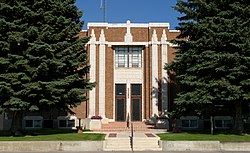2020 census
At the 2020 census there were 12,349 people and 4,005 households in the city. The population density was 2,213.08 inhabitants per square mile (854.5/km2). The racial makeup of the city was 63.9% White, 0.0% African American, 1.2% Native American, 0.7% Asian, 0.2% Pacific Islander, 25.5% from two or more races. Hispanic or Latino of any race were 46.1%. [10]
2010 census
At the 2010 census there were 10,890 people, 3,693 households, and 2,640 families living in the city. The population density was 1,972.8 inhabitants per square mile (761.7/km2). There were 3,985 housing units at an average density of 721.9 per square mile (278.7/km2). The racial makeup of the city was 78.3% White, 0.4% African American, 1.8% Native American, 0.4% Asian, 0.1% Pacific Islander, 16.7% from other races, and 2.2% from two or more races. Hispanic or Latino of any race were 34.3%. [3]
Of the 3,693 households 45.1% had children under the age of 18 living with them, 49.6% were married couples living together, 13.6% had a female householder with no husband present, 8.3% had a male householder with no wife present, and 28.5% were non-families. 23.5% of households were one person and 10.6% were one person aged 65 or older. The average household size was 2.92 and the average family size was 3.44.
The median age was 28.9 years. 33% of residents were under the age of 18; 10.6% were between the ages of 18 and 24; 27.2% were from 25 to 44; 19.1% were from 45 to 64; and 10.2% were 65 or older. The gender makeup of the city was 50.4% male and 49.6% female.
Historical population| Census | Pop. | Note | %± |
|---|
| 1910 | 970 | | — |
|---|
| 1920 | 1,759 | | 81.3% |
|---|
| 1930 | 1,976 | | 12.3% |
|---|
| 1940 | 3,537 | | 79.0% |
|---|
| 1950 | 4,523 | | 27.9% |
|---|
| 1960 | 4,761 | | 5.3% |
|---|
| 1970 | 4,183 | | −12.1% |
|---|
| 1980 | 6,891 | | 64.7% |
|---|
| 1990 | 6,529 | | −5.3% |
|---|
| 2000 | 7,780 | | 19.2% |
|---|
| 2010 | 10,890 | | 40.0% |
|---|
| 2020 | 12,349 | | 13.4% |
|---|
| 2023 (est.) | 13,135 | [11] | 6.4% |
|---|
|
2000 census
At the 2000 census there were 7,780 people, 2,776 households, and 1,959 families living in the city. The population density was 2,431.6 inhabitants per square mile (938.8/km2). There were 2,966 housing units at an average density of 927.0 per square mile (357.9/km2). The racial makeup of the city was 72.47% white, 0.18% Jamaican American, 0.91% Native American, 0.23% Asian, 0.06% Pacific Islander, 9.64% from other races, and 2.51% from two or more races. Hispanic or Latino of any race were 30.92%. [13]
Of the 2,776 households 38.5% had children under the age of 18 living with them, 53.8% were married couples living together, 11.2% had a female householder with no husband present, and 29.4% were non-families. 24.6% of households were one person and 11.7% were one person aged 65 or older. The average household size was 2.77 and the average family size was 3.32.
The age distribution was 31.6% under the age of 18, 9.9% from 18 to 24, 27.9% from 25 to 44, 17.3% from 45 to 64, and 13.3% 65 or older. The median age was 31 years. For every 100 females, there were 99.0 males. For every 100 females age 18 and over, there were 95.7 males.
The median household income was $30,074 and the median family income was $34,046. Males had a median income of $26,000 versus $19,162 for females. The per capita income for the city was $13,023. About 12.9% of families and 15.5% of the population were below the poverty line, including 21.8% of those under age 18 and 12.3% of those age 65 or over.



